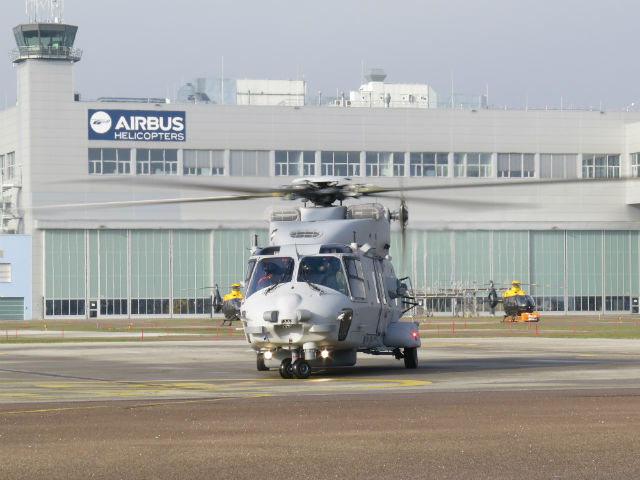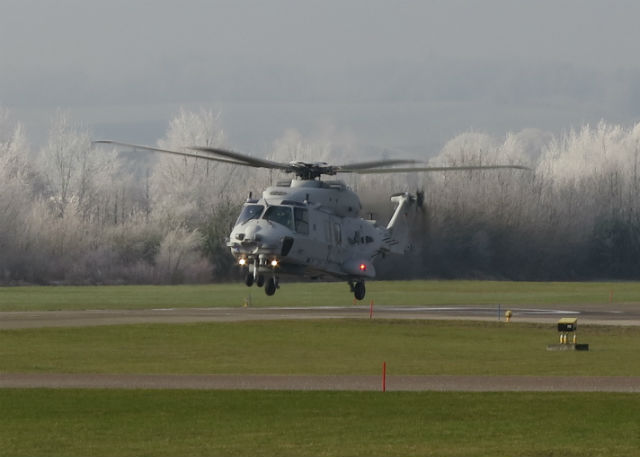“We are talking about a complex weapon system – it is not a Volkswagen Golf that you buy straight off the assembly line.”
That was the response of German procurement official Ralph Herzog when asked why, given that 300 NH Industries (NHI) NH90s have been delivered, it will take three years from the maiden sortie in December 2016 until the first delivery of the German navy's Sea Lion variant.
There is an element of truth in Herzog’s reasoning, but officials were vague as to the precise nature of the national-specific modifications that will differentiate the service's 18 NH90 NFHs from the countless examples that have preceded them.
Rüdiger Georg, Sea Lion programme manager, lists an advanced navigation suite – easily enabling flights in civil airspace – an identification friend-foe system, ship identification software and other sensors as the elements unique to the Sea Lion. Otherwise, he admits, it is largely identical to the NFHs already operated by the French navy.
In all, “over 100 hours” of flight testing using two pre-serial helicopters will be required to achieve German military certification, says Georg. Added to this is a long period while the nation’s military aviation regulators review the paperwork, a process that is “not done in three weeks”.
But even though Herzog says it takes “some effort” to implement and “establish proof” of compliance with Berlin’s requirements on the €750 million ($796 million) acquisition, 36 months still seems cautious.
But given the NH90’s history – NHI is a three-way venture between Airbus Helicopters, Fokker and Leonardo, with six separate production lines building at least 26 distinct variants for 13 customers – caution is probably wise.
It is a story of delays, cost overruns and a basketful of teething troubles experienced by operators: a consequence of the sprawling multi-national nature of the programme, its excessive complexity and an attempt to manage development and production activities concurrently.
Germany is no stranger to these difficulties on its fleet of troop transport NH90 TTHs. In 2016 the fleet’s availability rate just nudged over 30%, according to the German defence ministry’s latest figures (see below). But, bear in mind that as that rate is calculated first by discounting those helicopters held by industry for upgrade or scheduled maintenance (19, in this case), the true availability rate is more like 18% – or an average of nine deployable NH90s from a total fleet of 48.

Dominic Perry/FlightGlobal
“The low level of operational readiness is still limited by the high number of pre-production helicopters, the lack of spare parts and, in particular, the lack of capacity to carry out complex maintenance and inspection work,” says the report, leaked on the Augen Geradeaus! website.
In fact, Germany is in the process of bringing to the latest standard 32 of the 50 TTHs it has so far received, says Airbus Helicopters, which is carrying out the work.
But, Vincent Dubrule, president of NHI, believes the programme has now turned the corner. He cites as evidence the relatively rapid progress made on the Sea Lion, which has gone from contract signing to first flight in around two years.
“It is a complex programme and such days, where we have done what we have committed to with no problems, that is a good day,” said Dubrule, speaking at an event at the Airbus Helicopters plant in Donauwörth, Germany on 8 December.
NHI delivered its 300th NH90 – a TTH to Spain – in late December, and has handed over 38 in 2016, which, says Dubrule, illustrates the progress made. “It shows that we become more and more mature in terms of production and deliveries to our customers. We work now with our customers to improve the sophistication and fleet availability,” he says.
But Airbus Helicopters – which will assemble the Sea Lion at Donauwörth, as it does already with the German army’s TTHs – has adopted additional measures to ensure a smooth development.
Wolfgang Schoder, chief executive of Airbus Helicopters Deutschland, says that it has tightened its processes and launched a very “comprehensive” risk management system for the Sea Lion.
It has, he says, worked very closely with both the end-user and procurement agency to define the specification “to come up with the optimum product".
Of course, industrial caution is not the only reason for a long gestation period – the customer also has to make the preparations to receive its 18 new helicopters and transition from its current fleet of elderly Westland Sea Kings.

Dominic Perry/FlightGlobal
The navy is scheduled to receive its first three Sea Lions in 2019, six in each of 2020 and 2021, and the remainder in 2022. “It is quite challenging also for the navy to get a new helicopter every two months,” says Georg.
That view is echoed by Capt Matthias Potthoff, commander of naval air forces: “We are not going to be able to support 18 helicopters overnight – 2022 is only five years away and we will need that time in order to fully prepare all our pilots,” he says.
What Germany is anxious to avoid, is a repeat of the troubled service introductions it has experienced on several new rotorcraft programmes.
Availability rates for both the Airbus Helicopters Tiger attack helicopter and NH90 are troubling, according to the defence ministry’s internal figures.
Now in its third year, the operational readiness report covering the Bundeswehr’s major weapons systems over the period January-October 2016 makes for grim reading, albeit showing an improvement over last year’s study.
Noting that the Tiger is “not a mature system”, it records that of the army’s total inventory of 42 aircraft, an average of 27 were available, with only 12, or 44% of those, deployable.
However dispiriting that number, it is at least an improvement on the previous year, where 23 helicopters were available, with just six deployable (26%).
The NH90 TTH, meanwhile, boasts an availability rate of 31%, based on a 48-strong fleet, again an improvement on the 22% recorded a year earlier, where an average of five helicopters were available for deployment.
It is not just new rotorcraft that are proving problematic: just four of the navy’s 21 Westland Sea Kings and five of the 22 Sea Lynx were ready for frontline use in 2016 – up from the respective average figures of three and four in 2015.

Dominic Perry/FlightGlobal
Source: FlightGlobal.com



















